Group Riding
Something wonderful happens when you share something you love with others, and riding motorcycles is no exception. Group riding increases the fun factor in motorcycling, but beware, it adds to the risk factor, too. So if you’re going to ride in groups, try these 10 tips to make your group ride a safe and happy one.
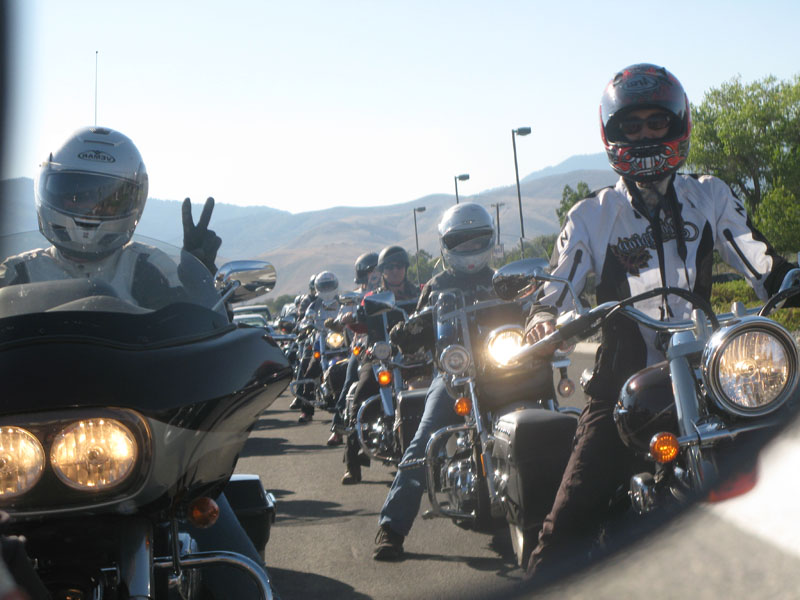
1. Be Prepared
Make sure everything—you, your gear and your motorcycle—are all ready to roll before heading out to the ride. Are you rested, fed, and drug and alcohol-free? Do you have rain gear? Are you dressed in layers for temperature changes? Is your bike running well and tank full of gas?
The TCLOCS acronym from the Motorcycle Safety Foundation (MSF) helps us remember the six components of a motorcycle to check before heading out on ride.
T – Tires and wheels
C – Controls
L – Lights and electrical systems
O – Oil, gas, and other fluids
C – Chassis (the bike's frame)
S – Side stand
You can download the complete T-CLOCS checklist and more at MSF-USA.org.
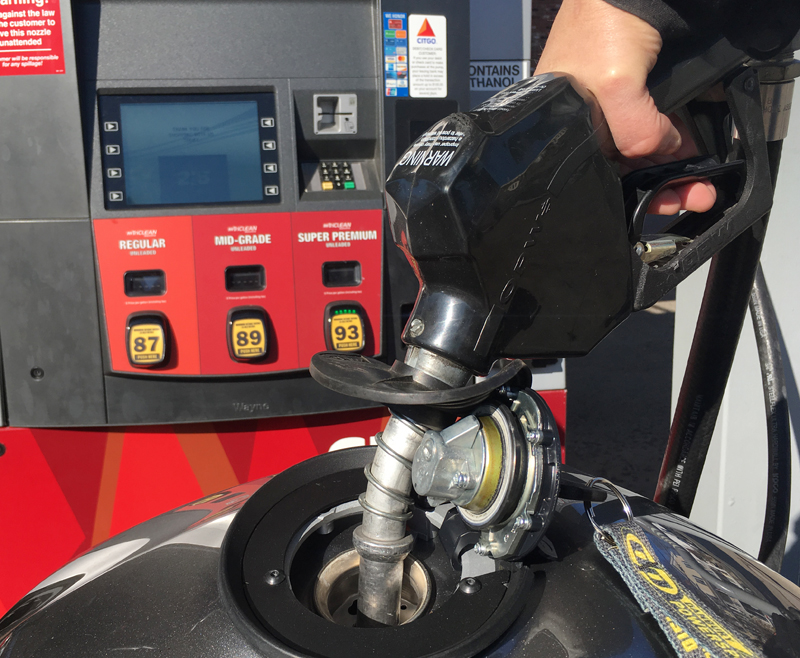
2. Have a Pre-ride Meeting
Even if you're only riding with one or two other riders, put your heads together before the ride to discuss stops, signals, skill levels, and speed. Large groups should divide into smaller ones (five to seven riders at most). Employ the buddy system. Exchange cell phone numbers and agree on designated meeting places in case anyone loses the pack.
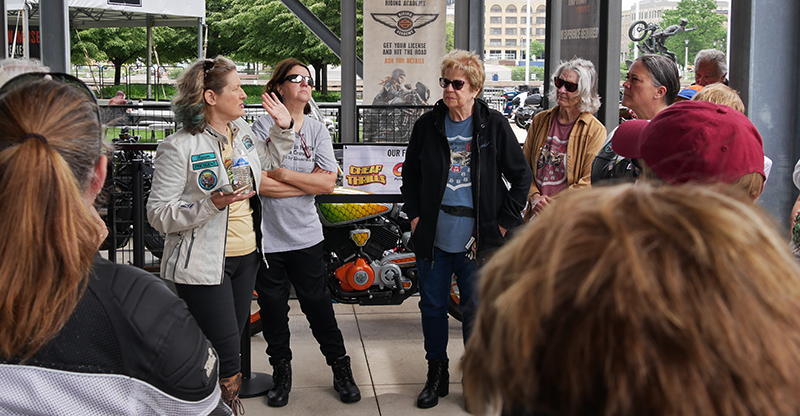
3. Learn the Riders' "Sign Language"
Hand signals will surely be used by riders in your group. For a complete guide to the most commonly used signals, use the MSF Guide to Group Riding.
4. Stay in Staggered Formation
Staggered riding is preferred when riding with others to provide maximum space cushion for each rider in the group without hogging the road. The lead rider takes the left third of the lane, with the second rider one-second behind in the right third of the lane. The third rider rides two seconds behind the lead rider, and so on.
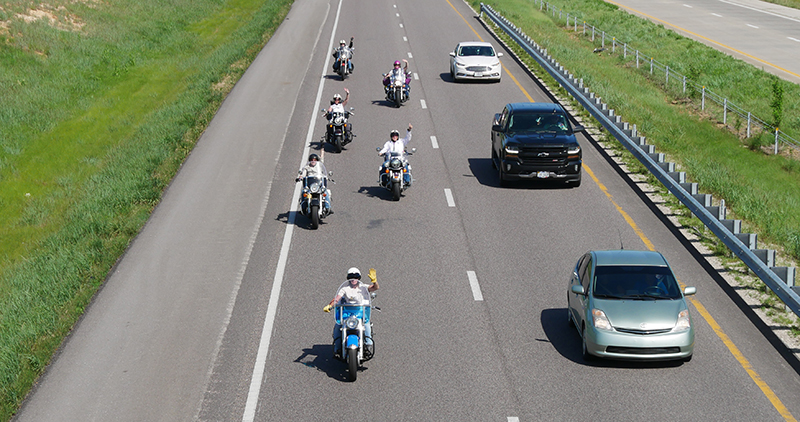
Single file and more space between bikes is best whenever more space cushioning is needed. This can be on curves, highway ramps, poor roads, and in bad weather conditions.
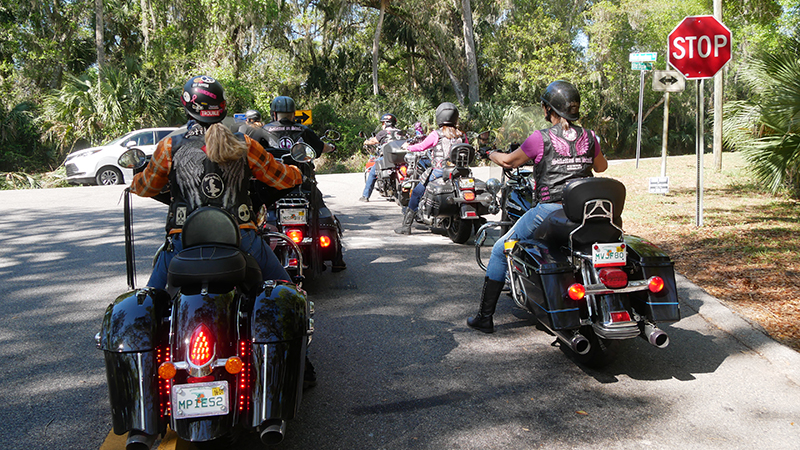
Riders stop side by side at intersections but should always move out one at a time, in tight formation, not side by side. Side-by-side riding reduces your space cushion and limits your ability to respond to unexpected hazards.
5. Placement in the Pack
The two strongest riders should be placed at the front and rear of the group. The lead rider sets the pace and the tail (sweep) rider brings up the rear. Inexperienced riders should be up front, behind the leader, allowing the leader to keep tabs and set the pace accordingly.
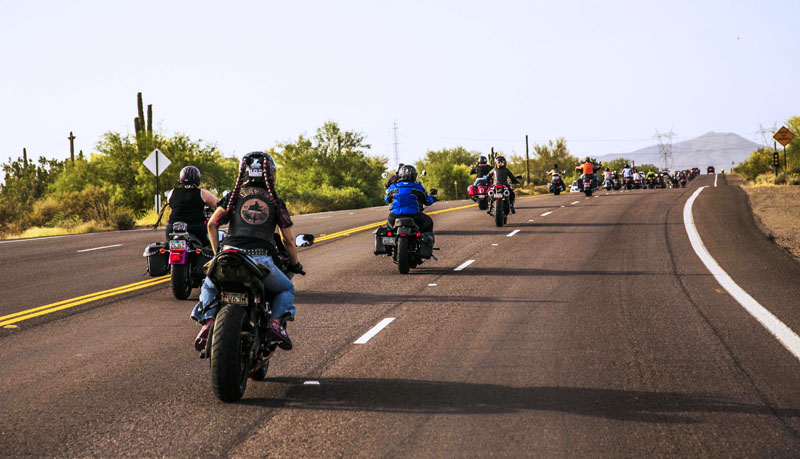
6. Pull Out the Stops
Make planned stops on the route, allowing everyone to rest. Even if the first riders to the rest stop have been waiting 15 minutes for the last riders to arrive, the last riders still need significant break time. Don't cut anyone short!
7. Parking
Park tightly, one at a time, in an orderly fashion. Consider pulling through parking spaces in parking lots to make it easier for the group to pull out. For rather large groups, pre-planned parking may be necessary.
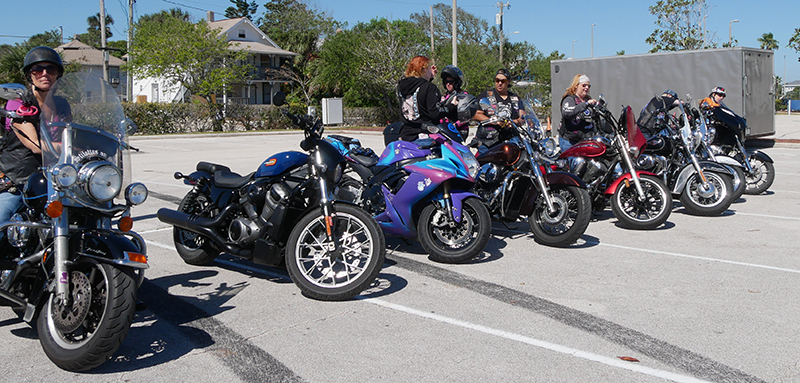
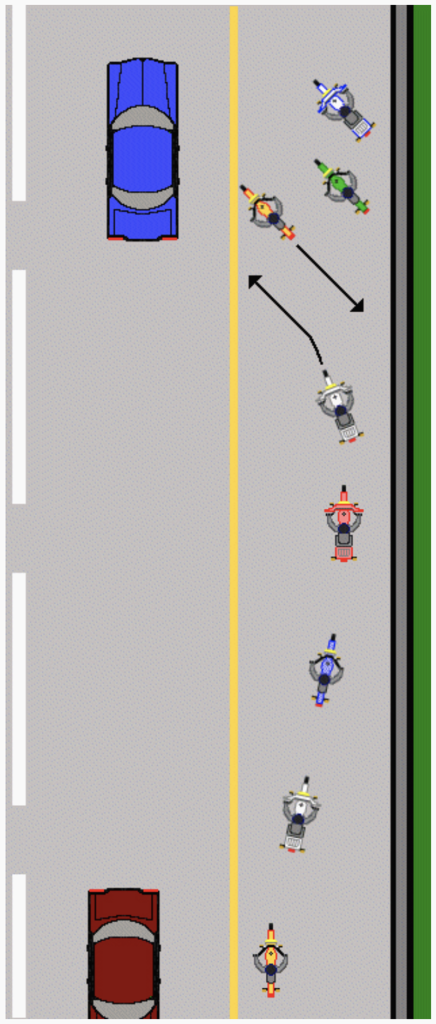
8. Must-have Items
At least one rider in the group must carry a cell phone, a first aid kit, and a tool kit. Ideally, every rider should have basic emergency equipment just in case. Don't forget your license, current vehicle registration, and proof of insurance, too. Wear a helmet even if you don't normally wear one, so that you don't have to stop at a state line to put it on.
9. What Will You Do When...
Have a plan in case you get too far behind or separated from the group. No need to push yourself to catch up. That's what cell phones and pre-determined meeting places are for!
What will you do if alcohol becomes involved? It’s best to discuss rules regarding drinking and riding before you take off. Remember, when one group member rides under the influence, he or she compromises the safety of the entire ride.
10. Ride Your Own Ride
Group riding can be a real treat, but it can also be a real threat. If you feel pressured beyond your personal ability, skill or comfort level for too long, your ride will suffer. Be choosy about your riding buddies. It's important to have fun, but only you can ride your own ride.

Good facts!
I have only one year of experience as a new rider. Reading articles such as yours has been valuable. It has made riding in groups much nicer knowing what to expect and what is expected. Thank you!
You’re welcome! Keep on reading and share Women Riders Now with your friends so we can continue to publish these great articles.Ride safe.
Sorry I don’t agree with #5. Slow riders should be at the back, ahead of sweep. Slower riders want to be with the group, yes, but not at the expense of the more experienced riders.
I love your articles! I have found them very valuable to my safety and the safety of those around me. I read them all. Please keep them coming.
So glad these are helpful for you Carolyn. Thanks for the feedback.
American Legion Ride Director Chapter 137 Fairfield, Alabama. I find a lot help in your articles. Thanks
When in a group and going through a round-a-bout intersection, should the riders go through the round-a-bout staggered or single file?
Good question! Anytime you come to any curve in the road, this includes round-a-bouts, it’s safest if the riders ride through single file.
Space and staggering are very important. Last weekend the leader made a snap decision to turn right onto another road. Sometimes I keep going rather than risk a high speed turn. At any rate a guy in front of me was going a bit fast. I said out loud in my helmet, Don’t do it dude. It ain’t worth it,” and his bike goes down. I was already scanning and responding. It was surreal and felt like slo-mo. I passed him on the left, parked across the street then ran over to him. Fortunately he was ok. All gear all the time! I shouted for folks to help pick up bike. Thanks to your article on how to pick up a bike, (which can be found here) I was empowered to take charge and bark orders.He had a few deep scratches on his hand. I was so mad at myself for not having items in the saddle bags. I was going to get around to it soon after winter. After reading other articles from you I whipped out my change purse with a few bandaids and Neosporin. His rear brake and peg was bent to hell. The guys had to cut the rear brake so the rear tire could spin. He went home and felt OK next day. Whew!
Some groups I want to ride with have members that don’t follow the basic group riding style described here and elsewhere. Over time (a year) their poor group riding behavior has not improved. I quit riding with that group because I haven’t figured out a polite but effective way to discuss the safety issue with this rider (or two actually). What do you suggest I do?
You ask a good question, one that I’ve put out to our readers on this page in the Your Questions Answered section of Women Riders Now. Click on the link to go to the story and scroll down to read the comments from our readers. If there are no comments there yet, keep checking back.
This is AWESOME! There are so many folks who have no idea about the cause and effect of this. This is a good article! A keeper!
Appreciate your feedback Jennifer. Please share this important article with your friends.
Following distance should be adequate to allow other to overtake one bike at a time (at min 2 sec.)Overtaking among the group should be discouraged.Avoid “log jams” when encountering slower traffic by maintaining gaps, and overtaking asap (lead riders stay in oncoming lane to signal safe overtaking for following bikes.Common sense trumps paint and colored lights!
We have always followed this procedure and it works very well. Good information for all riders.
Very timely article. Thanks you for sharing this. Francine answered a few questions for me.
In two-way traffic, all riders should stay AWAY from the center line. Too many fools ride like they have a right to that space. With the slightest mistake by a driver going the opposite way they have no time to react. Crash.
Good article. Most articles like this are safety oriented, which is most important but I never hear any tips to assist traffic flow. The “speed of traffic” in much of Ontario, Canada, is 10 to 20 kph above the posted limit. Often, bikes will travel below this especially if they are on a pleasure ride. On two lane roads a group of four or more riding in staggered or in-line formation makes it very difficult for a car to pass. I believe it is very important to leave a significant gap (4 to 5 sec.) to allow a car to pass no more than three bikes at once, preferably less. Riding in formation is fine but the riders must be mindful of when to open that gap to assist someone who is traveling faster to pass. After all, allowing a faster vehicle past in a controlled fashion is safer. I have never heard this taught in motorcycle safety courses or talked about in similar articles.
Spare key is essential. And in summer, everyone carries extra water and if possible a small tarp for shade if you break down out in the middle of nowhere. It can take longer than an hour for a tow truck. Extra water and shade are really good ideas.
Hi, I have passed this onto our group WA Women Motorcycle Riders.Our country rides tend to get spread out depending on the speed of riders. We always allow those in the need for speed, to go on ahead to a junction while the rest “catch up” in an orderly manner, so small groups do form.City riding is a little different — a bit hard to break up the ride into groups safely. We never have an issue though as these rides are a speed limit.Keep up the good work. I enjoy reading your articles.
Fantastic article on group riding. My thanks and greetings to Ms. Susan Rzepka Orion.
Hi there. I’m in Australia. We run a women’s ride group called Women2Wheels (Adelaide). We are always searching for good tips and information to impart to our ladies. This article is fantastic. We’ve shared it with our group on Facebook.
Nice refresher for older riders and good info for new riders. Thank you.
I have only been riding a little over a year now on the East Coast. I belong to an organization out here and we ride many organized rides, some ours and some with other clubs. Some weekends our organization is split going on several bike runs. My husband and I usually go together on the same run. As a woman and one with not a lot of time under her belt, so to speak, the men in our organization have been extremely helpful towards me in teaching the “ways” of organized riding. What I should do, what I shouldn’t do, etc. Our rides have consisted of anywhere from seven to well over 300 bikes. We have had police escorts, we have done blocking where needed, we have maintained the speed, we have not allowed line jumping. All in the name of safety. I am happy to say that in the nearly 20 organized bike rides that we had so far this year, we have not had a rider go down yet.To me I think it’s a matter of the group that you ride with, or the other clubs that you ride with. You learn which clubs ride hard and which ones don’t. The best advice has already been given…ride your own ride. Safety is the number one concern. I guess I have been extremely lucky to have hooked up with the guys that I have.
What excellent timing for this article to be posted. I am an Assistant District Director for ECN of the Motor Maids, and we are just about to have our pre-trip meeting. Our convention trip is taking us from Ontario to Cody Wyoming with seven riders, so your article makes me breathe easy to know that is still safe, as we discussed breaking up the group into two.
I will also print the riding tips for our members as a refresher and learning tool. Thank you again WRN.
Just a few comments about group riding for the ladies. For many men male testosterone seems to bubble up to the surface and overflow when riding a motorcycle. This makes for poor riding companions for the ladies who are sensible and enjoy the scenery and comaraderie. My advise is don't ride with them. They are dangerous to ride with and you'll stop riding rather than be scared out of your wits.
In 2002 I found many lady riders who have also become great friends through Women on Wheels, Northwind Riders Chapter, Illinois, and recommend all women visit the Web sites (WOW and NWR) to find a local chapter to join. If there isn't a chapter in your area, contact WOW and learn how to start one. There are many women who ride with their husbands or boyfriends who, like some women stated in their comments, do not follow group riding rules, are “competing” with each, or think it's “cute” to leave the women behind. This is no fun for us.
Our WOW rides are organized, within speed limits, with stops at interesting places, and always include a friendly, social, lunch. I've been to places I never would have known existed if it wasn't for the “girls.” This writeup seems to have turned into a commercial for Women on Wheels. That's a good thing. Check us out.
I am glad I found this Web site. The information is very helpful and should serve as a reminder to always ride safely and within your ability. Our local rides vary each time and more than once, I have come home wondering why I went on the ride in the first place. There is a tendency to get from point A to point B at warp speed despite the fact that the riding plan is an all-day ride. The road captain ignores the speed limit and explains, rather rationalizes, that we all “end up at the same place anyway” but I think it is rather reckless and wasn't the point to end up at the same place safeyl?!
There are times when our group will split into two to accommodate the different speeds but that seems to make the trip more risky and the “faster” group becomes impatient waiting for the “slower” group. After getting to our destination and we eat (the main reason for all trips, it seems), the “group ride” is basically “over” and each rider takes off on their own despite the distance we all traveled. Is that customary, part of an unspoken 'rule' or what? Because the “official group ride” is over when the destination is reached, some riders consume alcohol so due to that scenario, I should be glad that we are not all riding back together. However, drinking should not always be the end goal and I worry about the riders who have been drinking. This is one of the reasons why I do not enjoy large group rides.
Also, I was so looking forward for some “women only” rides but found myself pretty discouraged by the lack of women riders who cannot go on their own without their boyfriends/husbands, even for a half-day ride, much less an overnight ride. I work full time, getting another degree, raising a child, involved in civic organizations but riding is my stress reliever and I often go on solo rides which my husband envies but he has total confidence in my riding ability, resourcefulness, and common sense. Just sharing some thoughts.
This is a great article. I have been riding for 10 years this year. I was exposed to riding by an experienced rider of 35 years. He taught me these rules. I have been 105K on two wheels in 10 years, the past 2 1/2 years by myself on the East Coast. I live and breathe by this rule, “ride your own ride.” The second year is the hardest to convince yourself you do want to ride. Don't give up until after your third year/season of riding.
The tips and suggestions in this article are right on. I was a little leary when I got a 1200 Sporty and started riding again after being off a bike for a long time, but the HOG chapter here in Las Vegas is awesome to ride with and I got over that quickly because of it. They have new member rides every month for those who join and for those who want more time on their bikes with people who know how to ride. They are great people to ride with and very patient and helpful to all riders.
I have since traded in my Sporty and now have a Fat Boy and my HOG family was very excited for me and the first ride I had with them on my new bike was a great experience for me. They had many tips and hints for me and my new bike.
For those of you who are having trouble with your local HOG group I'm glad you have found other groups to ride with, but remember, not all HOG chapters are the same.
I want other women to know that if you don't like the way the group rides, stop riding with them. If it's not comfortable, they're not the group for you. Look for other riding organizations. There are lots of them out there.
When I moved to Florida, I joined the local HOG chapter and rode with them. They didn't follow safety rules, they were disorganized, and frankly, were dangerous. I've since found four other groups to ride with and couldn't be happier. I love riding with a group of women – no competition, just friendship and a love of riding.
Oh my, and I thought it was just me! I have had a problem keeping up. These guys are so competitive! I also have shed a few tears and also wanted to sell my bike. Now I feel better. Riding is so fun. Take a deep breath and remember cowgirls don't cry.
I have a question about riding in staggered formation. When riding with one or more in your group, and your group comes upon other fellow bikers, do we follow in formation with them? This would make the group too big and slow up traffic. My husband wasn't sure of the answer so I said I would put the question to you for guidance.
Yes, you would follow in formation, that is, unless your group wants to pass that group. On the road, there's no distinction between groups of riders, just as there are no distinctions between groups of car drivers — so when riding behind another group, it's important the group behind staggers appropriately with the group in front. If don't want to form such a big group, then leave enough following distance – at least two car lengths — to separate the two groups.
My husband and I rode a 5,200 mile iron-butt tour from Washington to Texas and back this summer. I wish I had read this article prior to departure, and discussed some of the information with him. We discovered that even though we've driven together in and around town and day trips around our home territory that cross country tours are a different breed of ride all together.
We are both great riders, but we discovered he's a better sweep as he doesn't always remember to ride for two rather than for one. Making moves like sudden exits off the Interstate without signaling gives the sweep no time to safely check their own traffic situation before making their own move, and often left us separated. We do not subscribe to cell phones, but we should have for the ride. The fear of becoming separated mid-country without a way to connect is daunting, to say the least. If you find yourself on a ride without such technology, agree on a person (trusted family member) to contact with your location.
I also agree on the importance of finding riders who have common interest. A rider interested in thrill seeking (my husband) and a rider who is primarily interested in seeing sights and stopping for breaks in cool locations for taking pictures (me), should definitely have at least one round table discussion, and agree, or at least, make decisions of compromise, before taking off.
It was a great ride of a lifetime, but would have been spectacular had we thought of some of the issues ahead of time.
I know what you mean about riding with your husband, or male significant other who has different expectations of a road trip. I did it years ago with my then boyfriend (now my husband) and there were a lot of disagreements on the trip because we didn't discuss expectations and riding styles beforehand. It was a big lesson learned the hard way.
I ride with my fiance, and sometimes we ride in groups. Some of our friends ride pretty fast, but we're the “slow pokes,” preferring to go the speed limit. Richard usually tells them to go on, we'll meet up with them later. Lots of excellent advice and tips in this article. Thanks. (I'm always squirreling away information for the day I get behind the bars!)
This says it all. I ride with a group of women based out of Cleveland, Ohio. We follow these exact rules, and have found that they are tried and true, for all levels of riders. Check us out on our Web site for more information on riding in Ohio with other lady riders. rumblepack.org, Women on Wheels
Dear Phyllis from NY (8.18.08),
You are right on with your observation so don't sell that bike. Trust your inner sense and you will travel many great miles. Ms. Susan is totally on with the “ride you own ride” logic. Keep on and your will just keep getting better.
I really appreciate this article. I was a passenger for many years before recently getting my own bike and taking the Basic Rider Safety Course. Being new to riding, I have a lot to learn and am having difficulty riding with my husband. I will definitely show this to him. It confirms some of how I thought group riding should be done and hopefully will settle some of our disagreements.
I love riding. I ride with a group of ladies once a month. We have a blast because it isn't about how fast you ride, but what you see along the way. I have been on rides and come home and said I would never go again, because I had trouble keeping up. We all need to remember that not everyone likes to ride wide open. I think the info on riding in a group was very helpful. Thank you for that.
We have a group that rides, usually 9 to 11 bikes. We take a big trip every year. One thing we do that was not mentioned and it works very well for us, is that we all have a set place in line and that is were we ride the entire trip. We never jockey positions. We start this way and end this way. It works for us so that we know exactly were every bike is going to be at all times. You know your rider in front of you and behind you. It makes things run very smooth
The information is great. I copied the signals and other information because I am a new rider. I really like your site. Filled with lots of good information on safety.
Great article. We often ride with six riders and four bikes with me being the only lady riding her own bike. I find that riding in the middle of the pack, I tend to be the one who keeps contol of the groups speed. The boys call me, “little mother” as I keep an eye on both the leader and the sweeper. If the riders in front see that I am falling behind they know that the last rider is further back then normal. Once we get back into formation all is good again.
The boys are trying to make me lead more, and this is helping me not to be such a “mother hen” although I still keep and eye on them all secretly.
Best advice: plan the ride, ride the plan.
The Baltimore Metro Chapter has adopted a “NO ONE LEFT BEHIND” philosophy with chapter group rides. The concept is simple. If the group is separated (traffic lights, etc) and you don't see the person behind you, you pull over to a safe spot and wait. If the person in front of you, does not see you, they pull over and wait. Eventually, everyone catches up with the group, no one misses a turn because someone is waiting for you and you all arrive safely and together as a group — which is the intension of riding in a “group.” And the number one rule is NOT to speed to catch up with the other riders.
A very good article and reminder for those who ride in groups often or occasionally.
The last group ride I went on I was riding on the back of my boyfriend's Road King. It was wild and ridiculous and unorganized. There was no formation and no plan — just men riding and trying to out-do one another to impress the terrified women in the group. I think that ride is when I made the decision to get my own bike. Now I own a 2009 Harley Sportster 1200 Custom and I just can't wait to get with a group that rides like a group. Thanks for this wonderful article!
This is an excellent article on how to ride in formation. Just did a group ride with my motorcycle club SWAT MC this past weekend to Williamsburg and Richmond, VA. I have been riding more than a year and one of the things that helped me greatly was going out riding with the Road Captain (Sniper) and receiving one-on-one training prior to my first group ride. This training was helpful in building my confidence. I learned how to ride in formation and keeping the formation tight so that cars won't get in, proper feet placement, hand signals, and being very alert. Also, after each group ride I've attended there is a discussion on what we did great as a group and as an individuals, along with areas that need improvement.
What a good read! I am a new rider and this was not only informative to me, but I now know what to expect and let other know as well. Thank you so much!
Sorry you had such a rough ride (Kelly 8/19/09). Group riding can be such an amazing experience. You are correct — safety should always be first, but unfortunately not all groups like to ride to the skill level of their least experienced rider.
Perhaps that is just not the right group for you. I personally ride with the local STAR Chapter, while a Yamaha based group, it welcomes with open arms any bike and rider. You should look up a chapter in your area. Check out a meeting see what you think. http://www.startouring.org.
This is a very good article. Sometimes when we ride we forget the most basic steps: communication before the ride starts. A group ride is not just meeting at a starting place and leaving.
After a horrendous ride yesterday with my local HOG chapter because of my inability to “keep up” with the more experienced riders, this article just confirms what I knew along, which is don't ride faster than your ability.
I came home nearly in tears ready to sell my brand new Harley because I was left behind and no one bothered to check in on me. My confidence was shattered. Luckily, three other riders in the group stayed with me and rode me all the way home.
I am going to email this to the road captains as well as the chapter director to remind them that this is supposed to be fun, and not a race, and that safety should always be first. Thanks for posting this article.